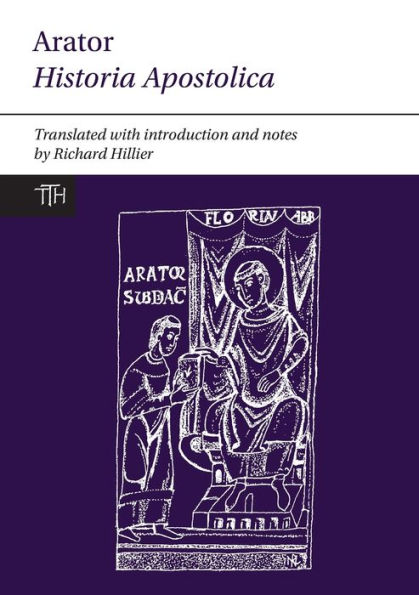Arator: Historia Apostolica
Arator's Historia Apostolica, published with papal approval and to great acclaim in 544, is an enthralling epic poem which retells the story of the Acts of Apostles, following clearly in the stylistic footsteps of Vergil and Lucan. On the other hand, it is also a detailed commentary on what Arator perceived to be the hidden meaning of the biblical text, divined and revealed through the technique of allegorical interpretation and drawing upon the exegesis of Origen, Ambrose, Augustine, and others. Narrative and commentary alternate throughout the work to enthralling effect, as the apostles Peter and Paul embark on their separate missionary adventures, eventually to be reunited in martyrdom in Nero's Rome.
The translation is preceded by an introduction which begins with a re-evaluation of the sources which detail Arator's life, in particular taking a fresh look at his relationship with his mentor Ennodius. There follows an examination of the poet's aims, methods and inspirations and a discussion of his attitudes to heresies both past and present. The introduction ends with a ground-breaking examination of the 'afterlife' of Arator's poem, mapping the extent of his influence, as evident in quotation and allusion, the copying of manuscripts, and inclusion in medieval libraries from the sixth century to the eleventh. Arator's influence on several later authors, most notably the Venerable Bede, is explored in more detail in a number of appendixes. Arator's combination of epic verse and mystical commentary was a heady and potent mix and ensured the poem's popularity, not least among the monks of Anglo-Saxon England and the Carolingian continent.
1136274806
The translation is preceded by an introduction which begins with a re-evaluation of the sources which detail Arator's life, in particular taking a fresh look at his relationship with his mentor Ennodius. There follows an examination of the poet's aims, methods and inspirations and a discussion of his attitudes to heresies both past and present. The introduction ends with a ground-breaking examination of the 'afterlife' of Arator's poem, mapping the extent of his influence, as evident in quotation and allusion, the copying of manuscripts, and inclusion in medieval libraries from the sixth century to the eleventh. Arator's influence on several later authors, most notably the Venerable Bede, is explored in more detail in a number of appendixes. Arator's combination of epic verse and mystical commentary was a heady and potent mix and ensured the poem's popularity, not least among the monks of Anglo-Saxon England and the Carolingian continent.
Arator: Historia Apostolica
Arator's Historia Apostolica, published with papal approval and to great acclaim in 544, is an enthralling epic poem which retells the story of the Acts of Apostles, following clearly in the stylistic footsteps of Vergil and Lucan. On the other hand, it is also a detailed commentary on what Arator perceived to be the hidden meaning of the biblical text, divined and revealed through the technique of allegorical interpretation and drawing upon the exegesis of Origen, Ambrose, Augustine, and others. Narrative and commentary alternate throughout the work to enthralling effect, as the apostles Peter and Paul embark on their separate missionary adventures, eventually to be reunited in martyrdom in Nero's Rome.
The translation is preceded by an introduction which begins with a re-evaluation of the sources which detail Arator's life, in particular taking a fresh look at his relationship with his mentor Ennodius. There follows an examination of the poet's aims, methods and inspirations and a discussion of his attitudes to heresies both past and present. The introduction ends with a ground-breaking examination of the 'afterlife' of Arator's poem, mapping the extent of his influence, as evident in quotation and allusion, the copying of manuscripts, and inclusion in medieval libraries from the sixth century to the eleventh. Arator's influence on several later authors, most notably the Venerable Bede, is explored in more detail in a number of appendixes. Arator's combination of epic verse and mystical commentary was a heady and potent mix and ensured the poem's popularity, not least among the monks of Anglo-Saxon England and the Carolingian continent.
The translation is preceded by an introduction which begins with a re-evaluation of the sources which detail Arator's life, in particular taking a fresh look at his relationship with his mentor Ennodius. There follows an examination of the poet's aims, methods and inspirations and a discussion of his attitudes to heresies both past and present. The introduction ends with a ground-breaking examination of the 'afterlife' of Arator's poem, mapping the extent of his influence, as evident in quotation and allusion, the copying of manuscripts, and inclusion in medieval libraries from the sixth century to the eleventh. Arator's influence on several later authors, most notably the Venerable Bede, is explored in more detail in a number of appendixes. Arator's combination of epic verse and mystical commentary was a heady and potent mix and ensured the poem's popularity, not least among the monks of Anglo-Saxon England and the Carolingian continent.
54.99
In Stock
5
1

Arator: Historia Apostolica
368
Arator: Historia Apostolica
368Paperback
$54.99
54.99
In Stock

Product Details
| ISBN-13: | 9781789621525 |
|---|---|
| Publisher: | Liverpool University Press |
| Publication date: | 10/22/2020 |
| Series: | Translated Texts for Historians LUP , #73 |
| Pages: | 368 |
| Product dimensions: | 8.20(w) x 5.80(h) x 0.90(d) |
About the Author
From the B&N Reads Blog
